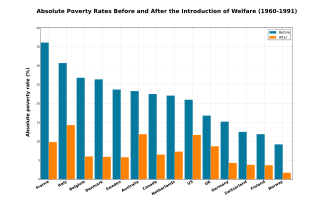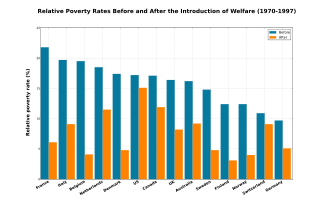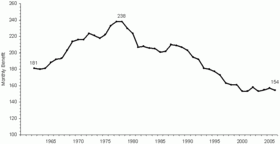Welfare's effect on poverty

The effects of social welfare on poverty have been the subject of various studies.[1]
Studies have shown that in welfare states, poverty decreases after countries adopt welfare programs.[2] Empirical evidence suggests that taxes and transfers considerably reduce poverty in most countries whose welfare states commonly constitute at least a fifth of GDP.[3][4][5][6][7][8] In 2013, the Organisation for Economic Co-operation and Development asserted that welfare spending is vital in reducing the ever-expanding global wealth gap.[9]
Table of effect


Timothy Smeeding used data from the Luxembourg Income Study to determine the effectiveness of anti-poverty and welfare programs on poverty reduction. The data for all the countries was from the year 2000 with the exception of the United Kingdom and the Netherlands for which the data was from 1999.[1]
| Country | Social expenditures on non-elderly[1][Notes 1] (as percentage of GDP) |
Total percent of poverty reduced[1] |
|---|---|---|
| 2.3 | 26.4 | |
| 9.6 | 65.2 | |
| 11.6 | 77.4 | |
| 7.3 | 70.5 | |
| 5.8 | 46.0 | |
| 10.9 | 69.7 | |
| 7.1 | 60.1 | |
| 9.3 | 76.9 | |
| 7.4 | 75.8 | |
| 4.3 | 57.7 | |
| 5.5 | 44.1 | |
| Average | 7.4 | 60.9 |
Table of poverty levels pre- and post-welfare


Two studies compare countries internationally before and after implementing social welfare programs. Using data from the Luxembourg Income Study, Bradley et al. and Lane Kenworthy measure the poverty rates both in relative terms (poverty defined by the respective governments) and absolute terms (poverty defined by 40% of United States median income), respectively. Kenworthy's study also adjusts for economic performance and shows that the economy made no significant difference in uplifting people out of poverty.
The studies look at the different countries from 1960 to 1991 (Kenworthy) and from 1970 to 1997 (Bradley et al.). Both these periods are roughly when major welfare programs were implemented such as the War on Poverty in the United States. The results of both studies show that poverty has been significantly reduced during the periods when major welfare programs were created.
| Country | Absolute poverty rate (1960–1991) (threshold set at 40% of United States median household income)[2] |
Relative poverty rate
(1970–1997)[4] | ||
|---|---|---|---|---|
| Pre-welfare | Post-welfare | Pre-welfare | Post-welfare | |
| 23.7 | 5.8 | 14.8 | 4.8 | |
| 9.2 | 1.7 | 12.4 | 4.0 | |
| 22.1 | 7.3 | 18.5 | 11.5 | |
| 11.9 | 3.7 | 12.4 | 3.1 | |
| 26.4 | 5.9 | 17.4 | 4.8 | |
| 15.2 | 4.3 | 9.7 | 5.1 | |
| 12.5 | 3.8 | 10.9 | 9.1 | |
| 22.5 | 6.5 | 17.1 | 11.9 | |
| 36.1 | 9.8 | 21.8 | 6.1 | |
| 26.8 | 6.0 | 19.5 | 4.1 | |
| 23.3 | 11.9 | 16.2 | 9.2 | |
| 16.8 | 8.7 | 16.4 | 8.2 | |
| 21.0 | 11.7 | 17.2 | 15.1 | |
| 30.7 | 14.3 | 19.7 | 9.1 | |
Opponents of welfare reducing poverty

In the United States, some members of both the Republican Party[12] and Democratic Party,[13] as well as third parties such as the Libertarian Party,[14] have favored reducing or eliminating welfare. The landmark piece of legislation which reduced welfare was the Personal Responsibility and Work Opportunity Act under the Clinton administration.
Conservative groups such as The Heritage Foundation[15] argue that welfare creates dependence, a disincentive to work and reduces the opportunity of individuals to manage their own lives.[16] This dependence is called a "culture of poverty", which is said to undermine people from finding meaningful work.[17] Many of these groups also point to the large budget used to maintain these programs and assert that it is wasteful.[15]
In the book Losing Ground, Charles Murray argues that welfare not only increases poverty, but also increases other problems such as single-parent households, and crime.[18]
Some socialists and Marxists argue that welfare states and modern social democratic policies limit the incentive system of the market by providing things such as minimum wages, unemployment insurance, taxing profits and reducing the reserve army of labor, resulting in capitalists having little incentive to invest. In essence, social welfare policies cripple the capitalist system and increase poverty. By implementing public or cooperative ownership of the means of production, some socialists believe there will be no need for a welfare state.[19][20]
Critics of welfare claim that too little of the transferred income actually reaches poor people, that the safety net welfare provides creates a "poverty trap" by reducing the initiative of poor people, and that welfare weakens the economy.[2]
A 2010 study examining the effects of the Personal Responsibility and Work Opportunity Reconciliation Act of 1996 found that the act's "welfare cutbacks did not increase poverty rates."[21]
Public opinion
In 2013, a NBC News/Wall Street Journal poll found that a plurality of Americans (24 percent) said "too much government welfare that prevents initiative" was the leading cause of poverty.[22]
A January 2014 Pew Research poll found that 49% of Americans believe government aid to the poor does more good than harm as people can not escape poverty until basic needs are met and 54% believe taxes should be increased on the wealthy and corporations to expand anti-poverty programs.[23]
See also
- Basic income
- Criticisms of welfare
- Involuntary unemployment
- Welfare economics
- Welfare trap
- Welfare dependency
Notes
- ^ This includes cash and near-cash spending (such as TANF and food stamps) and spending for public housing. It excludes healthcare and education spending.
References
- ^ a b c d e Smeeding, Timothy (2006). Poor People in Rich Nations: The United States in Comparative Perspective. Table 4, "The Antipoverty Effect of Government Spending: Percent of All Persons Poor". Journal of Economic Perspectives—Volume 20, Number 1—Winter 2006 —Pp. 69 –90.
- ^ a b c d Kenworthy, L. (1999). Do social-welfare policies reduce poverty? A cross-national assessment. Social Forces, 77(3), 1119–39.
- ^ Woolf, Steven; Aaron, Laudon. "U.S. Health in International Perspective". National Research Council and Institute of Medicine. pp. 171–72. Retrieved April 8, 2013.
- ^ a b c Bradley, D.; Huber, E.; Moller, S.; Nielson, F.; Stephens, J. D. (2003). "Determinants of Relative Poverty in Advanced Capitalist Democracies". American Sociological Review. 68 (3): 22–51. doi:10.2307/3088901. JSTOR 3088901.
- ^ Kevin Drum (26 September 2013). We Can Reduce Poverty If We Want To. We Just Have To Want To. Mother Jones. Retrieved 28 September 2013.
- ^ Gould, Elise and Wething, Hilary (24 July 2012). "U.S. poverty rates higher, safety net weaker than in peer countries." Economic Policy Institute. Retrieved 26 July 2013.
- ^ Zachary A. Goldfarb (9 December 2013). Study: U.S. poverty rate decreased over past half-century thanks to safety-net programs. The Washington Post. Retrieved 15 January 2015.
- ^ Kenworthy, Lane (February 2014). America's Social Democratic Future. Foreign Affairs. Retrieved 8 February 2014. See also: Kenworthy, Lane (2014). Social Democratic America. Oxford University Press. ISBN 0199322511
- ^ Wealth Gap Widens In Rich Countries As Austerity Threatens To Worsen Inequality: OECD. The Huffington Post. Retrieved 26 July 2013.
- ^ "GINI index (World Bank estimate) | Data". data.worldbank.org. Retrieved 2020-07-23.
- ^ 2008 Indicators of Welfare Dependence Figure TANF 2.
- ^ Republican Party on Welfare & Poverty, On The Issues
- ^ Democratic Party on Welfare & Poverty, On The Issues
- ^ Issues: Poverty and Welfare
- ^ a b Confronting the Unsustainable Growth of Welfare Entitlements: Principles of Reform and the Next Steps", The Heritage Foundation
- ^ Tanner, Michael (2008). "Welfare State". In Hamowy, Ronald (ed.). The Encyclopedia of Libertarianism. Thousand Oaks, CA: SAGE; Cato Institute. pp. 540–42. doi:10.4135/9781412965811.n327. ISBN 978-1-4129-6580-4. LCCN 2008009151. OCLC 750831024.
- ^ Niskanen, A. Welfare and the Culture of PovertyThe Cato Journal Vol. 16 No. 1
- ^ Murray, Charles (1984). Losing Ground: American Social Policy 1950–1980. Basic Books. pp. 58, 125, 115.
- ^ Encyclopedia of Marxism: Glossary of Terms
- ^ Wolff, Richard D. (15 April 2013). A New Political Strategy. Democracy at Work. Retrieved 28 July 2013. "...the best solutions to pressing social problems lie in going well beyond the state and welfare ("socialist") reforms of the past in the precise sense of changing the organization of enterprises, democratizing them into WSDEs (workers' self-directed enterprises)."
- ^ Borjas, George J. (November 22, 2015). "Does welfare reduce poverty?" (PDF). Research in Economics.
- ^ "Poll: Americans blame ‘government welfare’ for poverty," msnbc.com
- ^ Most See Inequality Growing, but Partisans Differ over Solutions. Pew Research Center, 23 January 2014. Retrieved 26 January 2014.
